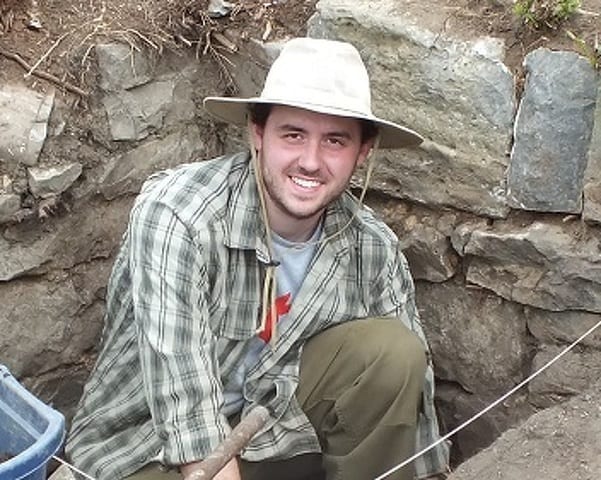For the introductory piece in this series, I reflected on the dual challenges facing those with an interest in exploring history: Investing the time and effort necessary for unearthing the lessons of the past and figuring out how to make them relevant and meaningful in the present.
For The Nittany Valley Society in particular, with our mission of cultural conservation, the focus on history is not so much about academic study or the preservation of knowledge as “mining” the past for stories and wisdom to enrich and inform. Embarking on such ventures can often bear unexpected fruit.
Two years ago, in another piece for Town&Gown online, I dealt with the work we were doing to catalog and index the archival collection of our local chamber of commerce, the CBICC. In that article, I invoked the words of former Penn State trustee Ben Novak, who furnishes us with an evocative metaphor for how we can “tap” the vast potential buried in the past:
“The past, because it was lived, cannot really be destroyed. It can only be covered over, like a lush jungle that gets condensed into a pool of oil or a vein of coal, just waiting to be drilled or mined to have its energy released… The past cannot be destroyed, but it can be neglected or covered over. When we don’t know what is in the past, we cannot use it, and we cannot release its power.”
After an introductory meeting for new CBICC members in 2013, I recognized such power enshrined in boxes of dusty archival materials. Staff pointed me to a set of recently rediscovered scrapbooks and photo albums (found, literally, in the back of a closet) dating back to the organization’s founding in the 1920s that contained everything from decades-old CDT clippings to photos of the Paterno family in a 1970s parade down College Avenue. Where some saw a discarded curiosity, we saw stories of the Nittany Valley waiting to be explored.
Here was evidence of effort — people who were obviously invested in the community and its growth had taken the time to set aside and showcase these documents and news clippings. Taken together, they formed an account of State College’s steady ascension from humble roots, and they also contained, for those willing to behold it, insight into the storytellers themselves, the community members who had built this collection; what they chose to save told us something about how they thought about the place and the hopes they held for its future.
The origins of the collection were long since forgotten along with any sense of what it contained. Our effort to index the contents and discover its treasures began with assessing the project scope, consulting with the Penn State Libraries to understand the right approach. Here I need to give special thanks to University archivist Jackie Esposito for her assistance. She provided crucial guidance throughout.
The process involved evaluating each individual item — for example, scanning through a newspaper clipping — then entering key data like title, origin date, and description into a spreadsheet. The size of the collection and the amount of time necessary for properly indexing all of it ultimately translated into a job for two undergraduate student interns spanning multiple semesters. Together, we embarked on a journey that became a valuable learning experience for all.
Certainly, the work brought many revealing moments, as I noted in that prior column. Insights into the eternally unfulfilled promise of an Allen Street pedestrian mall or the familiar revelry-outrage cycle surrounding Penn State “drinking holidays” help us to better understand and appreciate our place. But the experience yielded additional benefits beyond those of the final work product.
Our first intern completed her work for academic credit, which brought additional work requirements beyond the demands of the project itself. She needed to produce a research paper in order to fulfill these obligations, choosing the evolution of regional transportation as her topic. She gained unique experience in using primary source documents for historical research and also recorded original interviews with local luminaries such Mimi Barash Coppersmith and Sen. Doyle Corman about the growth and changes in Centre County.
When we engaged a second intern to continue the work, we got the chance to learn about his time with Penn State’s archaeological field school (pictured above). Live digs near the campus arboretum and in Shirleysburg offered students a chance to assist in ongoing projects exploring the history of our region. We found the work and the learning opportunity so interesting that we invited him to write a guest column about it for us on the Town&Gown website.
With any luck, both of our interns (who did great work) gained some new perspective on the community beyond their alma mater. However, the most unexpected and fortuitous outcome from the CBICC project may be the relationship we forged with the history professor who oversees the department’s undergrad internships. That resulted in development of a three-credit course on Penn State history, which will be offered in the coming years and supported by The Nittany Valley Society through an endowed fund. There will be much more to be said on that topic, but its beginnings are traced to this early and entirely unrelated effort.
What began with an impulse to recover memory and unleash the power buried in the past evolved into a lived experience that opened doors to new opportunities and relationships. Studying history, not excepting the process itself, teaches valuable lessons, including this one: The journey is often at least as important as the final destination.
This is the fourth installment of a multipart series that examines local efforts — by The Nittany Valley Society and others — to refresh the stories of our past so that the knowledge and experiences of those who came before us can make a tangible impact on the present. Next month, we will hear from those who have worked to preserve two of Centre County’s one-room schoolhouses.



